2007 CHEVROLET EQUINOX traction control
[x] Cancel search: traction controlPage 400 of 492
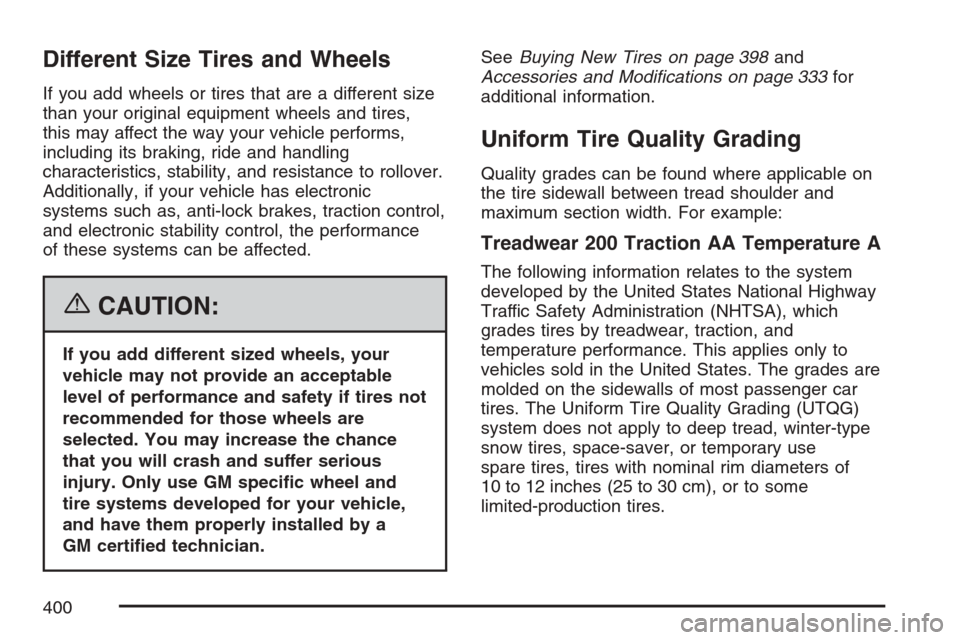
Different Size Tires and Wheels
If you add wheels or tires that are a different size
than your original equipment wheels and tires,
this may affect the way your vehicle performs,
including its braking, ride and handling
characteristics, stability, and resistance to rollover.
Additionally, if your vehicle has electronic
systems such as, anti-lock brakes, traction control,
and electronic stability control, the performance
of these systems can be affected.
{CAUTION:
If you add different sized wheels, your
vehicle may not provide an acceptable
level of performance and safety if tires not
recommended for those wheels are
selected. You may increase the chance
that you will crash and suffer serious
injury. Only use GM speci�c wheel and
tire systems developed for your vehicle,
and have them properly installed by a
GM certi�ed technician.SeeBuying New Tires on page 398and
Accessories and Modi�cations on page 333for
additional information.
Uniform Tire Quality Grading
Quality grades can be found where applicable on
the tire sidewall between tread shoulder and
maximum section width. For example:
Treadwear 200 Traction AA Temperature A
The following information relates to the system
developed by the United States National Highway
Traffic Safety Administration (NHTSA), which
grades tires by treadwear, traction, and
temperature performance. This applies only to
vehicles sold in the United States. The grades are
molded on the sidewalls of most passenger car
tires. The Uniform Tire Quality Grading (UTQG)
system does not apply to deep tread, winter-type
snow tires, space-saver, or temporary use
spare tires, tires with nominal rim diameters of
10 to 12 inches (25 to 30 cm), or to some
limited-production tires.
400
Page 401 of 492
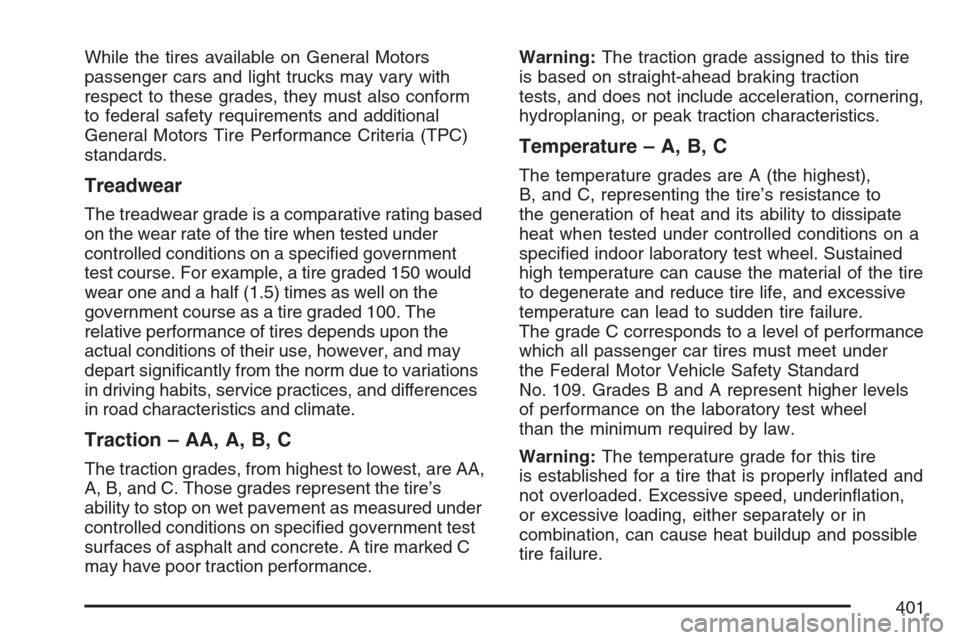
While the tires available on General Motors
passenger cars and light trucks may vary with
respect to these grades, they must also conform
to federal safety requirements and additional
General Motors Tire Performance Criteria (TPC)
standards.
Treadwear
The treadwear grade is a comparative rating based
on the wear rate of the tire when tested under
controlled conditions on a speci�ed government
test course. For example, a tire graded 150 would
wear one and a half (1.5) times as well on the
government course as a tire graded 100. The
relative performance of tires depends upon the
actual conditions of their use, however, and may
depart signi�cantly from the norm due to variations
in driving habits, service practices, and differences
in road characteristics and climate.
Traction – AA, A, B, C
The traction grades, from highest to lowest, are AA,
A, B, and C. Those grades represent the tire’s
ability to stop on wet pavement as measured under
controlled conditions on speci�ed government test
surfaces of asphalt and concrete. A tire marked C
may have poor traction performance.Warning:The traction grade assigned to this tire
is based on straight-ahead braking traction
tests, and does not include acceleration, cornering,
hydroplaning, or peak traction characteristics.
Temperature – A, B, C
The temperature grades are A (the highest),
B, and C, representing the tire’s resistance to
the generation of heat and its ability to dissipate
heat when tested under controlled conditions on a
speci�ed indoor laboratory test wheel. Sustained
high temperature can cause the material of the tire
to degenerate and reduce tire life, and excessive
temperature can lead to sudden tire failure.
The grade C corresponds to a level of performance
which all passenger car tires must meet under
the Federal Motor Vehicle Safety Standard
No. 109. Grades B and A represent higher levels
of performance on the laboratory test wheel
than the minimum required by law.
Warning:The temperature grade for this tire
is established for a tire that is properly in�ated and
not overloaded. Excessive speed, underin�ation,
or excessive loading, either separately or in
combination, can cause heat buildup and possible
tire failure.
401
Page 403 of 492
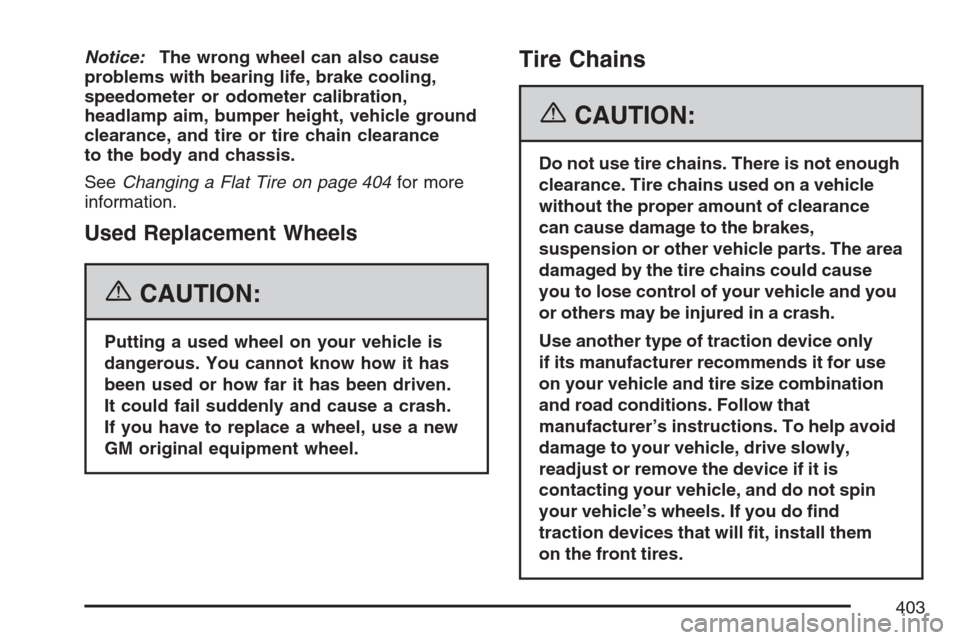
Notice:The wrong wheel can also cause
problems with bearing life, brake cooling,
speedometer or odometer calibration,
headlamp aim, bumper height, vehicle ground
clearance, and tire or tire chain clearance
to the body and chassis.
SeeChanging a Flat Tire on page 404for more
information.
Used Replacement Wheels
{CAUTION:
Putting a used wheel on your vehicle is
dangerous. You cannot know how it has
been used or how far it has been driven.
It could fail suddenly and cause a crash.
If you have to replace a wheel, use a new
GM original equipment wheel.
Tire Chains
{CAUTION:
Do not use tire chains. There is not enough
clearance. Tire chains used on a vehicle
without the proper amount of clearance
can cause damage to the brakes,
suspension or other vehicle parts. The area
damaged by the tire chains could cause
you to lose control of your vehicle and you
or others may be injured in a crash.
Use another type of traction device only
if its manufacturer recommends it for use
on your vehicle and tire size combination
and road conditions. Follow that
manufacturer’s instructions. To help avoid
damage to your vehicle, drive slowly,
readjust or remove the device if it is
contacting your vehicle, and do not spin
your vehicle’s wheels. If you do �nd
traction devices that will �t, install them
on the front tires.
403
Page 485 of 492
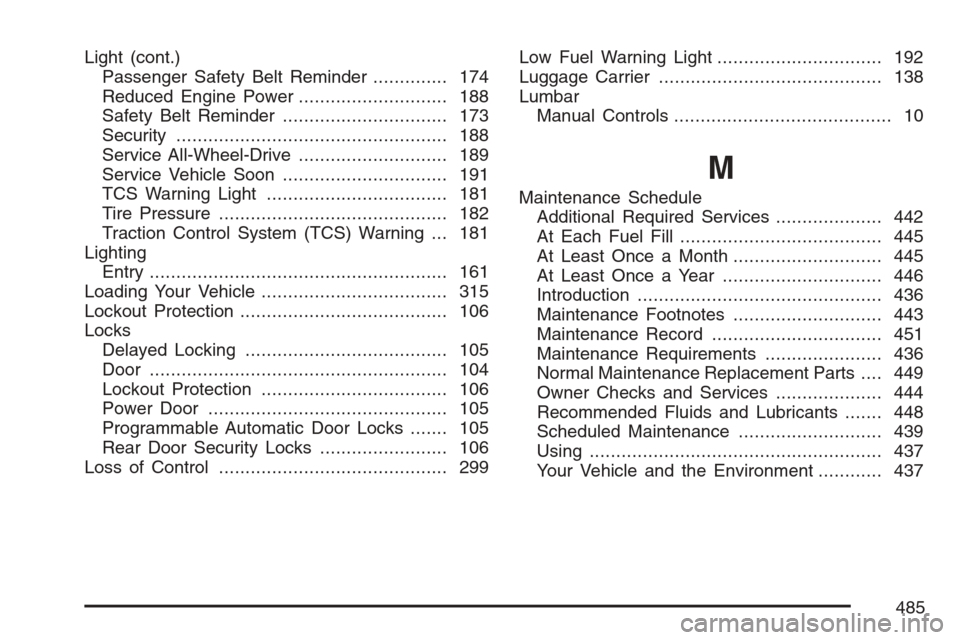
Light (cont.)
Passenger Safety Belt Reminder.............. 174
Reduced Engine Power............................ 188
Safety Belt Reminder............................... 173
Security................................................... 188
Service All-Wheel-Drive............................ 189
Service Vehicle Soon............................... 191
TCS Warning Light.................................. 181
Tire Pressure........................................... 182
Traction Control System (TCS) Warning ... 181
Lighting
Entry........................................................ 161
Loading Your Vehicle................................... 315
Lockout Protection....................................... 106
Locks
Delayed Locking...................................... 105
Door........................................................ 104
Lockout Protection................................... 106
Power Door............................................. 105
Programmable Automatic Door Locks....... 105
Rear Door Security Locks........................ 106
Loss of Control........................................... 299Low Fuel Warning Light............................... 192
Luggage Carrier.......................................... 138
Lumbar
Manual Controls......................................... 10
M
Maintenance Schedule
Additional Required Services.................... 442
At Each Fuel Fill...................................... 445
At Least Once a Month............................ 445
At Least Once a Year .............................. 446
Introduction.............................................. 436
Maintenance Footnotes............................ 443
Maintenance Record................................ 451
Maintenance Requirements...................... 436
Normal Maintenance Replacement Parts.... 449
Owner Checks and Services.................... 444
Recommended Fluids and Lubricants....... 448
Scheduled Maintenance........................... 439
Using....................................................... 437
Your Vehicle and the Environment............ 437
485
Page 491 of 492
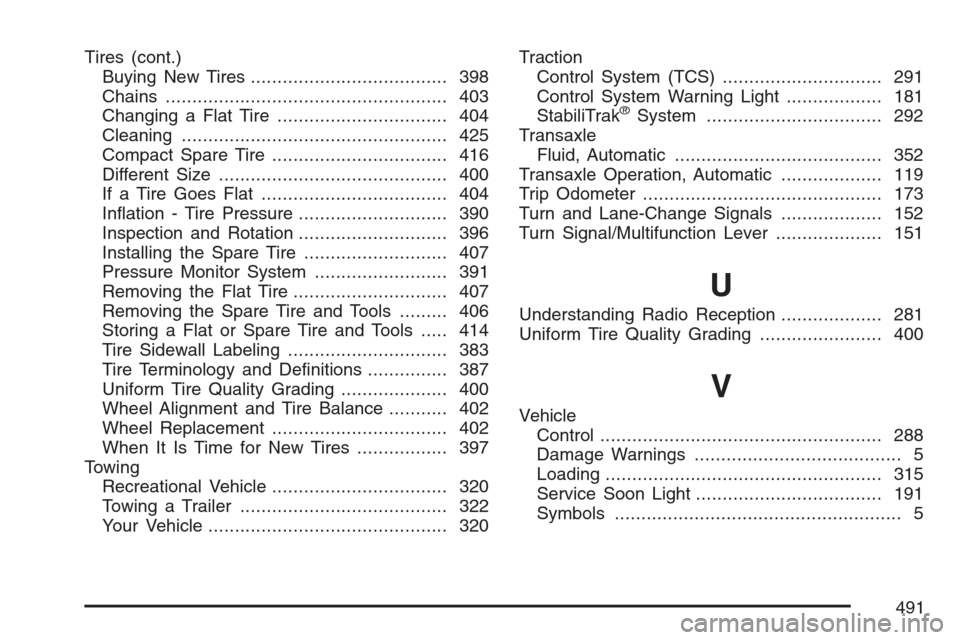
Tires (cont.)
Buying New Tires..................................... 398
Chains..................................................... 403
Changing a Flat Tire................................ 404
Cleaning.................................................. 425
Compact Spare Tire................................. 416
Different Size........................................... 400
If a Tire Goes Flat................................... 404
In�ation - Tire Pressure............................ 390
Inspection and Rotation............................ 396
Installing the Spare Tire........................... 407
Pressure Monitor System......................... 391
Removing the Flat Tire............................. 407
Removing the Spare Tire and Tools......... 406
Storing a Flat or Spare Tire and Tools..... 414
Tire Sidewall Labeling.............................. 383
Tire Terminology and De�nitions............... 387
Uniform Tire Quality Grading.................... 400
Wheel Alignment and Tire Balance........... 402
Wheel Replacement................................. 402
When It Is Time for New Tires................. 397
Towing
Recreational Vehicle................................. 320
Towing a Trailer....................................... 322
Your Vehicle............................................. 320Traction
Control System (TCS) .............................. 291
Control System Warning Light.................. 181
StabiliTrak
®System................................. 292
Transaxle
Fluid, Automatic....................................... 352
Transaxle Operation, Automatic................... 119
Trip Odometer............................................. 173
Turn and Lane-Change Signals................... 152
Turn Signal/Multifunction Lever.................... 151
U
Understanding Radio Reception................... 281
Uniform Tire Quality Grading....................... 400
V
Vehicle
Control..................................................... 288
Damage Warnings....................................... 5
Loading.................................................... 315
Service Soon Light................................... 191
Symbols...................................................... 5
491